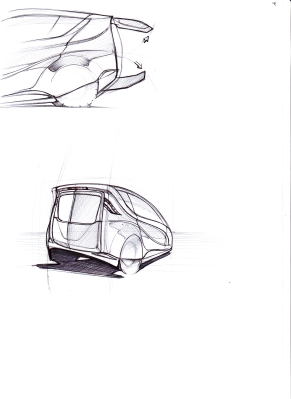Project Objectives
. Making a better learning experience by making the process of learning and teaching pleasant
. Reducing strict rules and regulations of the technical drawing course
. Strengthening the power of 3D visualization of objects
. Emotional Design
Duration: 4 months
Software: Solidworks, Keyshot,
Office, Autocad
My Role & Project Overview
For my industrial design bachelor's internship (2008), I collaborated with R&D department of Zamyad Automotive Manufacturing, focused on designing an innovative and affordable vehicle specifically for individuals with physical disabilities, particularly wheelchair users. The goal was to create a practical and ergonomic transportation solution that emphasized accessibility, comfort, and ease of use. The process involved comprehensive market research to understand the needs of disabled individuals, conceptual sketches to explore user-friendly designs, ergonomic studies to ensure seamless wheelchair integration, and detailed 3D modeling to deliver a manufacturable and inclusive vehicle concept.

Result of In-Depth Market Research
The market research revealed a significant gap in affordable and practical transportation options for wheelchair users in Iran. Key findings included:
Accessibility Challenges: Existing vehicles often required expensive aftermarket modifications, making them inaccessible to a majority of users. Common issues included high entry thresholds and lack of space for maneuvering wheelchairs.
Financial Constraints: The majority of the target audience sought cost-effective solutions due to financial limitations, highlighting the need for an affordable design without compromising on functionality.
Cultural Context: Family-oriented lifestyles emphasized the importance of accommodating both the wheelchair user and additional passengers in the same vehicle.
Infrastructure Considerations: Roads and parking spaces in urban and rural areas were not consistently accessible, increasing the need for adaptable and durable vehicle designs suited to uneven terrains.
User Preferences: Feedback from interviews with wheelchair users highlighted priorities such as ease of entry/exit, reliable wheelchair anchoring systems, comfortable seating, and simple, intuitive controls.
These insights guided the design process, ensuring the vehicle addressed the unique needs of wheelchair users in the Iranian context while maintaining affordability and usability.
The Conceptual Sketching













Ergonomic Studies
Optimal Ramp Design
Secure Wheelchair
Integration
User-Friendly Controls
Comfort and Safety
Interior
Space
Optimization
3D Modeling and Visualization




